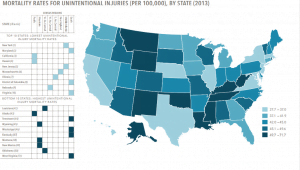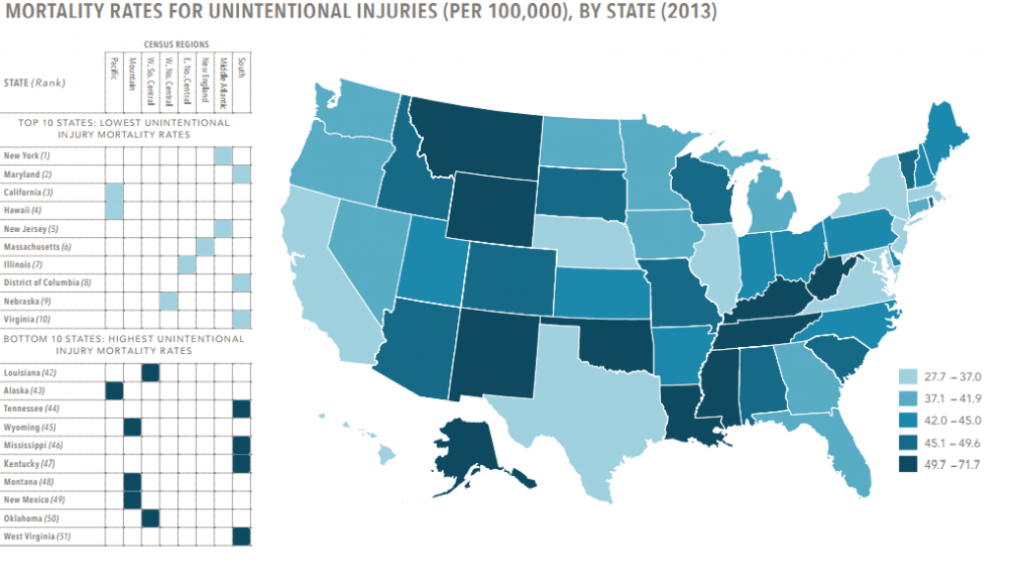Rates of Homicide and Drug Overdoses Differ More Than Seven-fold Across the US
Sarah BlackburnIn a pair of reports released this fall, the Virginia Commonwealth University (VCU) Center on Society and Health and the Urban Institute provide detailed information on how the prevalence of certain injuries and sexually transmitted infections differ by state, and how those outcomes are connected to dozens of potential drivers of health.
For example, the number of homicide-related deaths (per 100,000 people) varies by 7.2 times between states; New Hampshire’s rate of 1.7 (comparable to Finland) stands in stark contrast to Louisiana’s rate of 12.2 (comparable to Uganda). Rates of drug overdoses also vary by 7.2 times – from 4.1 in Maryland to 29.7 in West Virginia.
The reports, titled The Health of the States: Supplement 5: Spotlight on Sexually Transmitted Infections and The Health of the States: Supplement 6: Spotlight on Injury, are part of a series of reports from the Health of the States project. Funded by the Robert Wood Johnson Foundation (RWJF), the HOTS (Health of the States) project is a detailed, expanded analysis of state rankings on 39 health outcomes, and correlations between those health outcomes and 123 determinants of health spanning five domains: health care, health behaviors, social and economic factors, the physical and social environment, and public policies and spending. By assessing and assembling these health outcomes and determinants of health, the project provides a nuanced and textured profile of the links between health and potential drivers, such as safety of schools and neighborhoods, exposure to adverse childhood experiences (ACES), expanded Medicaid coverage, and investments in transit and social programs. These data are exposing new patterns in health outcomes and drivers that could be used to develop new policies and practices to improve population health and wellbeing.
A Summary Report and the first supplement, Spotlight on Methods, were released in October 2016, followed by supplements 2 (Life Expectancy and Mortality), 3 (Birth Outcomes), and 4 (Child and Adolescent Health) earlier this year. The recent supplements take a more detailed look at how states perform on several measures of sexually transmitted infections and injury, including motor vehicle accidents, drug overdoses, suicide, HIV, and gonorrhea. For each of these measures and more, researchers provide data on outcomes for all 50 states and Washington, D.C., depict findings in maps and figures, and discuss regional trends.

In addition, researchers explore the connections between these outcomes and 123 determinants of health – highlighting the strongest of those connections and providing context for why states may perform well or not. For example, rates of all the sexually transmitted infections studied correlate strongly with social and economic factors – particularly poverty and racial segregation.The 10 states with the lowest rates of motor vehicle fatalities have six times as many residents living in walkable neighborhoods as the 10 states with the highest rates of motor vehicle fatalities have.
In the coming months, the VCU Center on Society and Health will release the remaining HOTS supplements, offering more detail on the relationships discovered between health outcomes and their social determinants:
- Spotlight on adult health status
- Spotlight on overweight/obesity, diabetes, and cardiovascular conditions
- Spotlight on cancer, lower respiratory disease, influenza and pneumonia, and Alzheimer’s disease
Visit the Center’s website to learn more about HOTS, download the reports, and explore the data.





All comments will be reviewed and posted if substantive and of general interest to IAPHS readers.